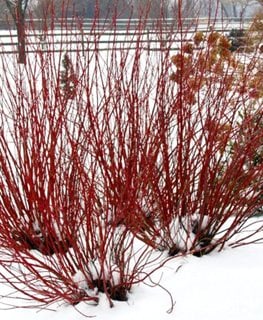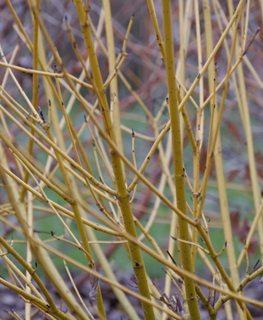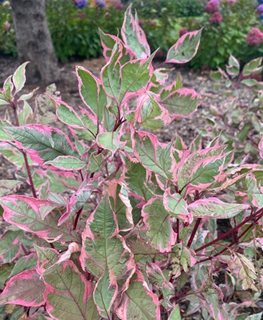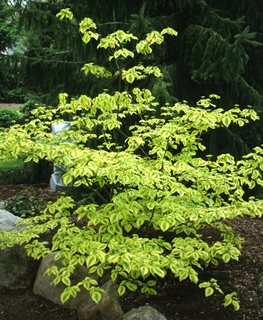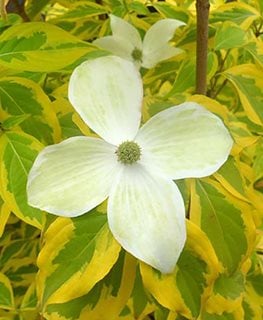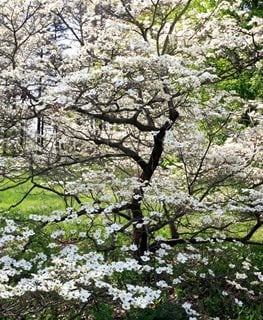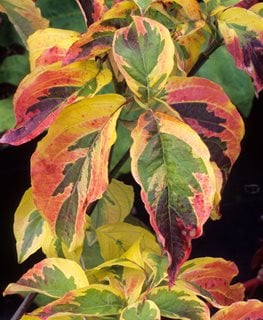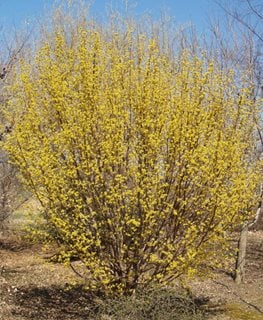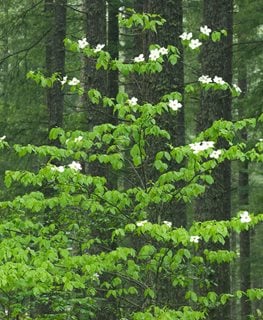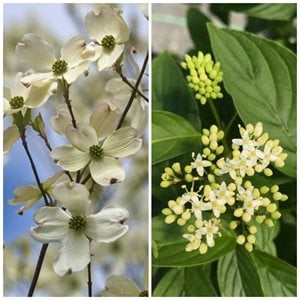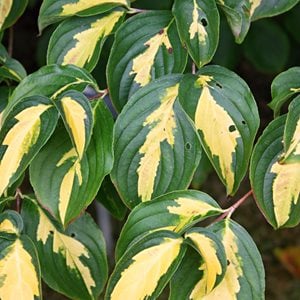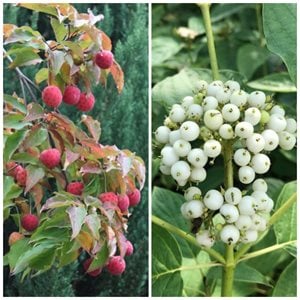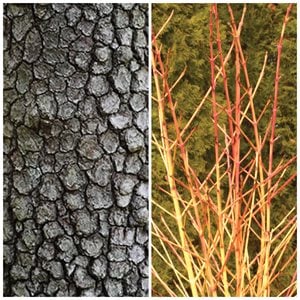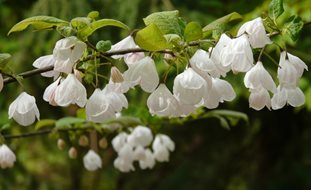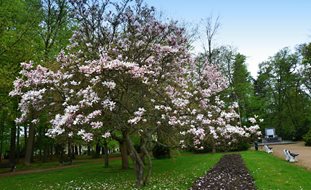How to Grow Flowering Dogwood Trees & Shrubs
America’s most popular native flowering tree thrives in the home garden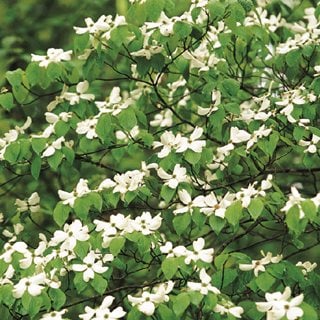
The dogwood’s profuse blooms appear between late March and mid-May and linger for weeks, giving way to green leaves in the summer. Photo by: Mark Turner.
Dogwood trees and shrubs, some of the most popular in the country, offer an unmatched four-season display of beauty. The main attraction is the appearance of the showy white or pink flowers (actually bracts) that herald the arrival of spring. Unfussy in its care requirements, the dogwood readily thrives in the home landscape and grows quickly.
On this page: Basics | Types | Planting | Care & Pruning | Varieties | Seasonal Beauty | FAQs | Design Ideas
On this page:
- BASICS
- TYPES OF DOGWOODS
- PLANTING DOGWOODS
- DOGWOOD CARE & PRUNING
- DOGWOOD VARIETIES
- ALL-SEASON BEAUTY
- FREQUENTLY ASKED QUESTIONS
- DESIGN IDEAS
BASICS
Zones:
2-9, depending on variety
Size:
Shrubs 3 to 5 feet tall and wide; trees from 10 to 25 feet tall with a trunk diameter of 6 to 12 inches.
Exposure:
Full sun to partial or full shade, depending on variety.
Bloom time:
Mid-March through May, depending on variety.
Growth rate:
Most dogwood shrubs and trees grow quickly, with a fast rate of over a foot a year. Trees will reach full size in about a decade.
Flower color:
White is the usual color of the dogwood’s petal-like bracts, but some are pink or even pale red, such as C. florida ‘Rubra’.
Foliage:
Like other deciduous trees and shrubs, the leaves of a dogwood are green during summer and change to an attractive reddish-purple during the fall, before dropping to the ground.
Form:
Trees are rounded with horizontal branching. Dogwood bushes have an upright habit.
Are dogwoods deer resistant?
Deer resistance varies slightly between types, but for most, Rutgers rates them as seldom to occasionally damaged by deer.
TYPES OF DOGWOODS
Types:
There are many types of dogwoods, ranging from small shrubs to single-trunked ornamental trees. Following is a list of some common types, some of which are American natives and others that come from Asia and Europe.
- Cornus florida: Flowering dogwood, North American native, tree
- Cornus kousa: Kousa dogwood, Asian native, tree
- Cornus alternifolia: Pagoda dogwood, North American native, large shrub or small tree
- Cornus mas: Cornelian cherry dogwood, European & Asian native, large shrub or small tree
- Cornus nuttallii: Pacific dogwood, North American native, large shrub or small tree
- Cornus sanguinea: Bloodtwig dogwood, European & Asian native, shrub
- Cornus amomum spp. obliqua: Swamp dogwood, North American native, shrub
- Cornus stolonifera: Red osier dogwood, North American native, shrub
Learn more about dogwood shrubs.
PLANTING DOGWOODS
When to plant:
Plant dogwoods in the spring, before tree growth starts and when the soil is moist.
Where to plant:
Dogwoods thrive in both sun and shade, making it a great understory tree or shrub.
Soil:
Dogwoods do best in moist, well-drained, slightly acidic soil that contains organic matter.
Planting tips:
- Dig an extra-wide hole to ensure the roots have room to grow outwards
- Don’t plant too deeply, the root flare should be above ground level
- For container grown dogwoods, loosen the root ball with a soil knife to prevent the roots from continuing to grow in the circular shape of the pot
- For bare root dogwoods, soak the roots in a bucket of water prior to planting
- Create a berm of soil around the outer edge of the root ball to hold water
Companion plants:
Plant with witch hazel, redbud and oakleaf hydrangea.
DOGWOOD CARE & PRUNING
Pruning:
Dogwood trees and shrubs have a naturally attractive shape, so they require little pruning unless needed for aesthetic reasons or to improve their vigor. The best time to prune is in the late winter (when the tree is dormant) to early spring, before new foliage emerges.
Watering:
Water your dogwood on a regular basis until it is established. Then, provide additional water during hot dry spells and mulch to help retain moisture. Keep the mulch pulled back a few inches from the tree trunk. Most dogwood trees prefer moist soils, with many shrub types tolerating boggy conditions, so they aren't necessarily drought tolerant.
Fertilizing:
Be careful when fertilizing a young dogwood shrub or tree—many newly planted trees are killed by applying too much fertilizer. For this reason it is often safest to hold off on fertilizing until your tree is in its second season. If you have an established dogwood that you feel would benefit from fertilization, have your soil tested to determine the best course of action. Additionally, fertilizer applied too late in the season can stimulate new growth that is vulnerable to winter damage.
Diseases:
Dogwoods are prone to anthracnose, which causes leaf spotting and twig dieback, and powdery mildew, which appears as a white coating on leaves. Reduce risk by watering during droughts to keep trees vigorous, ensuring good air circulation, avoiding overhead watering, and pruning out diseased growth.
Pests:
The dogwood borer is the most common insect pest. Larvae tunnel under the bark, often entering through wounds or pruning cuts. Early signs include small wet spots on bark in early summer; advanced symptoms may show loose bark, crown dieback, or sawdust-like frass at entry holes. (Source: Missouri Botanical Garden). Healthy trees are less likely to get attacked.
To reduce risk, keep trees healthy, avoid bark injury, and prune only in dormant months.
DOGWOOD PICTURES
Many dogwood shrubs and trees are available for purchase online. You can expect to pay approximately $20 to $100 or more depending on the size and variety.
ALL-SEASON BEAUTY
Although the dogwood is a relatively small tree — its magnificent all-season beauty makes a big impact in the residential garden.
SPRING
Blooms appear on both trees and shrubs between late March and mid-May and often last as long as three or four weeks.
Trees (left): Flowers on trees tend to be single and larger.
Shrubs (right): Flowers on shrubs are smaller and form in clusters.
SUMMER
Blossoms give way to glossy green leaves, some with striking white or yellow variegation. Foliage is similar on trees and shrubs.
AUTUMN
Berries follow the flowers and attract birds, providing food through fall and winter. Berry color varies depending on the variety.
Trees (left): As with the flowers, berries are single and larger on trees.
Shrubs (right): Clusters of small berries follow the flowers on shrubs.
Get ideas for an alluring autumn garden.
See more trees and shrubs with colorful berries.
WINTER
Trees (left): After the leaves drop, the dogwood’s graceful horizontal branches and scale-like bark take center stage. If you’re lucky, the scarlet berries will linger into winter, enhancing the unique beauty of the textured bark.
Shrubs (right): Many dogwood shrubs display colorful stems in the winter in shades of yellow, red, coral, and orange. (Pictured: Arctic Sun® dogwood)
See eight more trees with distinctive bark.
FREQUENTLY ASKED QUESTIONS
Do dogwoods need full sun?
Most dogwoods bloom best with at least a half-day of sun, though many also tolerate partial to full shade. Shrub dogwoods are especially versatile.
Are dogwoods messy?
No. Dogwoods drop their leaves in fall like most deciduous plants, but their small fruits are eaten quickly by birds, minimizing cleanup.
Do dogwoods attract wildlife?
Yes. Over 30 bird species feed on dogwood berries, and pollinators visit the spring flowers. Their layered branches also provide nesting sites.
How long do dogwoods live?
With proper care, most dogwood trees can live 30–50 years, though some well-sited specimens live much longer.
What is the best time to prune dogwoods?
Late winter to early spring, before new growth begins. Avoid pruning from April to June to reduce the risk of borer damage.
Are dogwoods fast-growing?
Yes, most grow more than a foot per year and reach mature size within 10–15 years, depending on the type.
LANDSCAPE IDEAS WITH DOGWOODS
Dogwoods shine in a wide range of garden settings thanks to their multi-season interest and adaptability. Use them as focal points, in groupings, or as part of a layered planting design.
- Woodland gardens: Flowering dogwoods thrive as understory trees, pairing beautifully with redbuds, azaleas, and ferns in dappled shade.
- Foundation plantings: Rounded forms and showy flowers soften the lines of buildings and create a welcoming entryway.
- Mixed borders: Combine shrub dogwoods with hydrangeas, viburnum, or ornamental grasses for year-round texture and color.
- Wildlife gardens: Berries feed birds through fall and winter, while flowers attract pollinators in spring.
- Winter accents: Red- or yellow-stemmed dogwoods stand out in snowy landscapes and can be planted together for a dramatic color contrast.
- Rain gardens: Shrub dogwoods tolerate wet soils, making them excellent for rain gardens and low areas.
Enjoy garden travel? Check out our local self-guided day trips and other travel destinations. Sign up for our Garden Travel Newsletter to be alerted when new travel opportunities are available!
ABOUT THE AUTHOR
Anne Balogh is a longtime gardening writer and editor for Garden Design, with over 20 years of experience covering everything from container planting to landscape trends. She draws inspiration from her own Zone 5 garden in Illinois, where she experiments with hardy perennials and flowering annuals.
